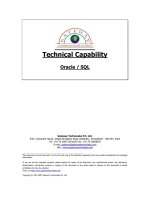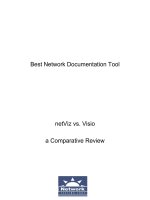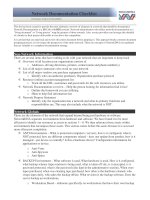Tài liệu WEB2PY- P5 doc
Bạn đang xem bản rút gọn của tài liệu. Xem và tải ngay bản đầy đủ của tài liệu tại đây (534.19 KB, 50 trang )
FORM 185
Hidden fields
When the above form object is serialized by {{=form}}, and because of the
previous call to the accepts method, it now looks like this:
1 <form enctype="multipart/form-data" action="" method="post">
2 your name:
3 <input name="name" />
4 <input type="submit" />
5 <input value="783531473471" type="hidden" name="_formkey" />
6 <input value="default" type="hidden" name="_formname" />
7 </form>
Notice the presence of two hidden fields: " formkey" and " formname".
Their presence is triggered by the call to accepts and they play two different
and important roles:
• The hidden field called "
formkey" is a one-time token that web2py
uses to prevent double submission of forms. The value of this key is
generated when the form is serialized and stored in the session. When
the form is submitted this value must match, or else accepts returns
False without errors as if the form was not submitted at all. This is
because web2py cannot determine whether the form was submitted
correctly.
• The hidden field called "
formname" is generated by web2py as a
name for the form, but the name can be overridden. This field is neces-
sary to allow pages that contain and process multiple forms. web2py
distinguishes the different submitted forms by their names.
Please purchase PDF Split-Merge on www.verypdf.com to remove this watermark.
186 FORMS AND VALIDATORS
The role of these hidden fields and their usage in custom forms and pages
with multiple forms is discussed in more detail later in the chapter.
If the form above is submitted with an empty "name" field, the form does
not pass validation. When the form is serialized again it appears as:
1 <form enctype="multipart/form-data" action="" method="post">
2 your name:
3 <input value="" name="name" />
4 <div class="error">cannot be empty!</div>
5 <input type="submit" />
6 <input value="783531473471" type="hidden" name="_formkey" />
7 <input value="default" type="hidden" name="_formname" />
8 </form>
Notice the presence of a DIV of class "error" in the serialized form.
web2py inserts this error message in the form to notify the visitor about
the field that did not pass validation. The accepts method, upon submission,
determines that the form is submitted, checks whether the field "name" is
empty and whether it is required, and eventually inserts the error message
from the validator into the form.
The base "layout.html" view is expected to handle DIVs of class "error".
The default layout uses jQuery effects to make errors appear and slide down
with a red background. See Chapter 10 for more details.
keepvalues
The full signature of the accepts method is the following:
1 form.accepts(vars, session=None, formname='default',
2 keepvalues=False, onvalidation=None):
The optional argument keepvalues tells web2py what to do when a form
is accepted and there is no redirection, so the same form is displayed again.
By default the form is cleared. If keepvalues is set to True, the form is
prepopulated with the previously inserted values. This is useful when you
have a form that is supposed to be used repeatedly to insert multiple similar
records.
onvalidation
The onvalidation argument can be None or can be a function that takes the
form and returns nothing. Such a function would be called and passed the
form, immediately after validation (if validation passes) and before anything
else happens. The purpose of this function is multifold. It can be used, for
example, to perform additional checks on the form and eventually add errors
Please purchase PDF Split-Merge on www.verypdf.com to remove this watermark.
FORM 187
to the form. It can also be used to compute the values of some fields based on
the values of other fields. It can be used to trigger some action (like sending
an email) before a record is created/updated.
Here is an example:
1 db.define_table('numbers',
2 Field('a', 'integer'),
3 Field('b', 'integer'),
4 Field('d', 'integer', readable=False, writable=False))
5
6 def my_form_processing(form):
7 c = form.vars.a
*
form.vars.b
8 if c < 0:
9 form.errors.b = 'a
*
b cannot be negative'
10 else:
11 form.vars.c = c
12
13 def insert_numbers():
14 form = SQLFORM(db.numbers)
15 if form.accepts(request.vars, session,
16 onvalidation=my_form_processing)
17 session.flash = 'record inserted'
18 redirect(request.url)
19 return dict(form=form)
Forms and redirection
The most common way to use forms is via self-submission, so that the
submitted field variables are processed by the same action that generated the
form. Once the form is accepted, it is unusual to display the current page
again (something we are doing here only to keep things simple). It is more
common to redirect the visitor to a "next" page.
Here is the new example controller:
1 def display_form():
2 form = FORM('Your name:',
3 INPUT(_name='name', requires=IS_NOT_EMPTY()),
4 INPUT(_type='submit'))
5 if form.accepts(request.vars, session):
6 session.flash = 'form accepted'
7 redirect(URL(r=request, f='next'))
8 elif form.errors:
9 response.flash = 'form has errors'
10 else:
11 response.flash = 'please fill the form'
12 return dict(form=form)
13
14 def next():
15 return dict()
Please purchase PDF Split-Merge on www.verypdf.com to remove this watermark.
188 FORMS AND VALIDATORS
In order to set a flash on the next page instead of the current page you must
use session.flash instead of response.flash. web2py moves the former
into the latter after redirection. Note that using session.flash requires that
you do not session.forget().
Multiple forms per page
The content of this section applies to both FORM and SQLFORM objects.
It is possible to have multiple forms per page, but you must allow web2py
to distinguish them. If these are derived by SQLFORM from different tables, then
web2py gives them different names automatically; otherwise you need to
explicitlygivethemdifferentform names. Moreover, whenmultiple formsare
present on the same page, the mechanism for preventing double submission
breaks, and you must omit the session argument when calling the accepts
method. Here is an example:
1 def two_forms():
2 form1 = FORM(INPUT(_name='name', requires=IS_NOT_EMPTY()),
3 INPUT(_type='submit'))
4 form2 = FORM(INPUT(_name='name', requires=IS_NOT_EMPTY()),
5 INPUT(_type='submit'))
6 if form1.accepts(request.vars, formname='form_one'):
7 response.flash = 'form one accepted'
8 if form2.accepts(request.vars, formname='form_two'):
9 response.flash = 'form two accepted'
10 return dict(form1=form1, form2=form2)
and here is the output it produces:
When the visitor submits an empty form1, only form1 displays an error; if
the visitor submits an empty form2, only form2 displays an error message.
Please purchase PDF Split-Merge on www.verypdf.com to remove this watermark.
SQLFORM 189
No self-submission
The content of this section applies to both FORM and SQLFORM objects. What
we discuss here is possible but not recommended, since it is always good
practice to have forms that self-submit. Sometimes, though, you don’t have
a choice, because the action that sends the form and the action that receives
it belong to different applications.
It is possible to generate a form that submits to a different action. This is
done by specifying the URL of the processing action in the attributes of the
FORM or SQLFORM object. For example:
1 form = FORM(INPUT(_name='name', requires=IS_NOT_EMPTY()),
2 INPUT(_type='submit'), _action=URL(r=request, f='page_two'))
3
4 def page_one():
5 return dict(form=form)
6
7 def page_two():
8 if form.accepts(request.vars, formname=None):
9 response.flash = 'form accepted'
10 else:
11 response.flash = 'there was an error in the form'
12 return dict()
Notice that since both "page one" and "page two" use the same form, we
have defined it only once by placing it outside of all the actions, in order
not to repeat ourselves. The common portion of code at the beginning of a
controller gets executed every time before giving control to the called action.
Since "page
one" does not call accepts, the form has no name and no key,
so you must not pass the session and set formname=None in accepts, or the
form will not validate when "page two" receives it.
7.2 SQLFORM
We now move to the next level by providing the application with a model file:
1 db = DAL('sqlite://db.db')
2 db.define_table('person',
3 Field('name', requires=IS_NOT_EMPTY()))
Modify the controller as follows:
1 def display_form():
2 form = SQLFORM(db.person)
3 if form.accepts(request.vars, session):
4 response.flash = 'form accepted'
5 elif form.errors:
6 response.flash = 'form has errors'
7 else:
Please purchase PDF Split-Merge on www.verypdf.com to remove this watermark.
190 FORMS AND VALIDATORS
8 response.flash = 'please fill out the form'
9 return dict(form=form)
The view does not need to be changed.
In the new controller, you do not need to build a FORM, since the SQLFORM
constructor built one from the table db.person defined in the model. This new
form, when serialized, appears as:
1 <form enctype="multipart/form-data" action="" method="post">
2 <table>
3 <tr id="person_name__row">
4 <td><label id="person_name__label"
5 for="person_name">Your name: </label></td>
6 <td><input type="text" class="string"
7 name="name" value="" id="person_name" /></td>
8 <td></td>
9 </tr>
10 <tr id="submit_record__row">
11 <td></td>
12 <td><input value="Submit" type="submit" /></td>
13 <td></td>
14 </tr>
15 </table>
16 <input value="9038845529" type="hidden" name="_formkey" />
17 <input value="person" type="hidden" name="_formname" />
18 </form>
The automatically generated form is more complex than the previous low-
level form. First of all, it contains a table of rows, and each row has three
columns. The first column contains the field labels (as determined from the
db.person), the second column contains the input fields (and eventually error
messages), and the third column is optional and therefore empty (it can be
populated with the fields in the SQLFORM constructor).
All tags in the form have names derived from the table and field name.
This allows easy customization of the form using CSS and JavaScript. This
capability is discussed in more detail in Chapter 10.
More important is that now the accepts method does a lot more work
for you. As in the previous case, it performs validation of the input, but
additionally, if the input passes validation, it also performs a database insert
of the newrecord and stores in form.vars.id the unique "id" of the newrecord.
A SQLFORM object also deals automatically with "upload" fields by saving
uploaded files in the "uploads" folder (after having them renamed safely to
avoid conflicts and prevent directory traversal attacks) and stores their names
(their new names) into the appropriate field in the database.
A SQLFORM displays "boolean" values with checkboxes, "text" values with
textareas, values required to be in a definite set or a database with dropboxes,
and "upload" fields with links that allow users to download the uploaded files.
Please purchase PDF Split-Merge on www.verypdf.com to remove this watermark.
SQLFORM 191
It hides "blob" fields, since they are supposed to be handled differently, as
discussed later.
For example, consider the following model:
1 db.define_table('person',
2 Field('name', requires=IS_NOT_EMPTY()),
3 Field('married', 'boolean'),
4 Field('gender', requires=IS_IN_SET(['Male', 'Female', 'Other'])),
5 Field('profile', 'text'),
6 Field('image', 'upload'))
In this case, SQLFORM(db.person) generates the form shown below:
The SQLFORM constructor allows various customizations, such as displaying
only a subset of the fields, changing the labels, adding values to the op-
tional third column, or creating UPDATE and DELETE forms, as opposed to
INSERT forms like the current one.
SQLFORM is the single biggest time-saver object in web2py.
The class SQLFORM is defined in "gluon/sqlhtml.py". It can be easily ex-
tended by overloading its xml method, the method that serializes the objects,
to change its output.
The signature for the SQLFORM constructor is the following:
1 SQLFORM(table, record=None, deletable=False,
2 linkto=None, upload=None, fields=None, labels=None, col3={},
Please purchase PDF Split-Merge on www.verypdf.com to remove this watermark.
192 FORMS AND VALIDATORS
3 submit_button='Submit', delete_label='Check to delete:',
4 id_label='Record id: ', showid=True,
5 readonly=False, comments=True, keepopts=[],
6 ignore_rw=False,
**
attributes)
• The optional second argument turns theINSERT form into an UPDATE
form for the specified record (see next subsection).
• If deletable is set to True, the UPDATE form displays a "Check to
delete" checkbox. The value of the label if this field is set via the
delete
label argument.
• submit
button sets the value of the submit button.
• id
label sets the label of the record "id"
• The "id" of the record is not shown if showid is set to False.
• fields is an optional list of field names that you want to display. If a
list is provided, only fields in the list are displayed. For example:
1 fields = ['name']
• labels is a dictionary of field labels. The dictionary key is a field name
and the corresponding value is what gets displayed as its label. If a
label is not provided, web2py derives the label from the field name (it
capitalizes the field name and replaces underscores with spaces). For
example:
1 labels = {'name':'Your Full Name:'}
• col3 is a dictionary of values for the third column. For example:
1 col3 = {'name':A('what is this?',
2 _href=' />• linkto and upload are optional URLs to user-defined controllers that
allow the form to deal with reference fields. This is discussed in more
detail later in the section.
• readonly. If set to True, displays the form as readonly
• comments. If set to False, does not display the col3 comments
• ignore
rw. Normally, for a create/update form, only fields marked as
writable=True are shown, and for readonly forms, only fields marked
as readable=True are shown. Setting ignore rw=True causes those con-
straints to be ignored, and all fields are displayed. This is mostly used
Please purchase PDF Split-Merge on www.verypdf.com to remove this watermark.
SQLFORM 193
in the appadmin interface to display all fields for each table, overriding
what the model indicates.
• Optional attributes are arguments starting with underscore that you
want to pass to the FORM tag that renders the SQLFORM object. Examples
are:
1 _action = '.'
2 _method = 'POST'
There is a special hidden attribute. When a dictionary is passed as
hidden, its items are translated into "hidden" INPUT fields (see the
example for the FORM helper in Chapter 5).
Insert/Update/Delete SQLFORM
If you pass a record as optional second argument to the SQLFORM constructor,
the form becomes an UPDATE form for that record. This means that when
the form is submitted the existing record is updated and no new record is
inserted. If you set the argument deletable=True, the UPDATE form displays
a "check to delete" checkbox. If checked, the record is deleted.
You can, for example, modify the controller of the previous example so
that when we pass an additional integer argument in the URL path, as in:
1 /test/default/display_form/2
and if there is a record with the corresponding id, the SQLFORM generates an
UPDATE/DELETE form for the record:
1 def display_form():
2 if len(request.args):
3 records = db(db.person.id==request.args[0]).select()
4 if len(request.args) and len(records):
5 form = SQLFORM(db.person, records[0], deletable=True)
6 else:
7 form = SQLFORM(db.person)
8 if form.accepts(request.vars, session):
9 response.flash = 'form accepted'
10 elif form.errors:
11 response.flash = 'form has errors'
12 return dict(form=form)
Line 3 finds the record, line 5 makes an UPDATE/DELETE form, and line
7 makes an INSERT form. Line 8 does all the corresponding form processing.
Here is the final page:
Please purchase PDF Split-Merge on www.verypdf.com to remove this watermark.
194 FORMS AND VALIDATORS
By default deletable=False.
Edit forms also contain a hidden INPUT field with name="id" which is used
to identify the record. This id is also stored server-side for additional security
and, if the visitor tampers with the value of this field, the UPDATE is not
performed and web2py raises a SyntaxError, "user is tampering with form".
When a Field is marked with writable=False, the field is not shown in
create forms, and it is is shown readonly in update forms. If a field is marked
as writable=False and readable=False, then the field is not shown at all, not
even in update forms.
Forms created with
1 form = SQLFORM( ,ignore_rw=True)
ignore the readable and writable attributes and always show all fields.
Forms in appadmin ignore them by default.
Forms created with
1 form = SQLFORM(table,record_id,readonly=True)
always show all fields in readonly mode, and they cannot be accepted.
SQLFORM in HTML
There are times when you want to use SQLFORM to benefit from its form
generation and processing, but you need a level of customization of the form
in HTML that you cannot achieve with the parameters of the SQLFORM object,
so you have to design the form using HTML.
Now, edit the previous controller and add a new action:
Please purchase PDF Split-Merge on www.verypdf.com to remove this watermark.
SQLFORM 195
1 def display_manual_form():
2 form = SQLFORM(db.person)
3 if form.accepts(request.vars, formname='test'):
4 response.flash = 'form accepted'
5 elif form.errors:
6 response.flash = 'form has errors'
7 else:
8 response.flash = 'please fill the form'
9 return dict()
and insert the form in the associated "default/display manual form.html"
view:
1 {{extend 'layout.html'}}
2 <form>
3 <ul>
4 <li>Your name is <input name="name" /></li>
5 </ul>
6 <input type="submit" />
7 <input type="hidden" name="_formname" value="test" />
8 </form>
Notice that the action does not return the form because it does not need to
pass it to the view. The view contains a form created manually in HTML.
The form contains a hidden field " formname" that must be the same form-
name specified as an argument of accepts in the action. web2py uses the
form name in case there are multiple forms on the same page, to determine
which one was submitted. If the page contains a single form, you can set
formname=None and omit the hidden field in the view.
SQLFORM and uploads
Fields of type "upload" are special. They are rendered as INPUT fields of
type="file". Unless otherwise specified, the uploaded file is streamed in
using a buffer, and stored under the "uploads" folder of the application using
a new safe name, assigned automatically. The name of this file is then saved
into the field of type uploads.
As an example, consider the following model:
1 db.define_table('person',
2 Field('name', requires=IS_NOT_EMPTY()),
3 Field('image', 'upload'))
You can use the same controller action "display form" shown above.
When you insert a new record, the form allows you to browse for a file.
Choose, for example, a jpg image. The file is uploaded and stored as:
1 applications/test/uploads/person.image.XXXXX.jpg
"XXXXXX" is a random identifier for the file assigned by web2py.
Please purchase PDF Split-Merge on www.verypdf.com to remove this watermark.
196 FORMS AND VALIDATORS
Notice that, by default, the original filename of an uploaded file
is b16encoded and used to build the new name for the file. This
name is retrieved by the default "download" action and used to
set the content disposition header to the original filename.
Only its extension is preserved. This is a security requirement since the
filename may contain special characters that could allow a visitor to perform
directory traversal attacks or other malicious operations.
The new filename is also stored in form.vars.image
newfilename.
When editing the record using an UPDATE form, it would be nice to
display a link to the existing uploaded file, and web2py provides a way to
do it.
If you pass a URL to the SQLFORM constructor via the upload argument,
web2py uses the action at that URL to download the file. Consider the
following actions:
1 def display_form():
2 if len(request.args):
3 records = db(db.person.id==request.args[0]).select()
4 if len(request.args) and len(records):
5 url = URL(r=request, f='download')
6 form = SQLFORM(db.person, records[0], deletable=True, upload=
url)
7 else:
8 form = SQLFORM(db.person)
9 if form.accepts(request.vars, session):
10 response.flash = 'form accepted'
11 elif form.errors:
12 response.flash = 'form has errors'
13 return dict(form=form)
14
15 def download():
16 return response.download(request, db)
Now, insert a new record at the URL:
1 http://127.0.0.1:8000/test/default/display_form
Upload an image, submit the form, and then edit the newly created record
by visiting:
1 http://127.0.0.1:8000/test/default/display_form/3
(hereweassumethe latestrecordhasid=3). The formlooks like thefollowing:
Please purchase PDF Split-Merge on www.verypdf.com to remove this watermark.
SQLFORM 197
This form, when serialized, generates the following HTML:
1 <td><label id="person_image__label" for="person_image">Image: </label
></td><td><div><input type="file" id="person_image" class="upload
" name="image" />[<a href="/test/default/download/person.image
.0246683463831.jpg">file</a>|<input type="checkbox" name="
image__delete" />delete]</div></td><td></td></tr><tr id="
delete_record__row"><td><label id="delete_record__label" for="
delete_record">Check to delete:</label></td><td><input type="
checkbox" id="delete_record" class="delete" name="
delete_this_record" /></td>
which contains a link to allow downloading of the uploaded file, and a check-
box to remove the file from the database record, thus storing NULL in the
"image" field.
Why is this mechanism exposed? Why do you need to write the download
function? Because you may want to enforce some authorization mechanism
in the download function. See Chapter 8 for an example.
Storing the original filename
web2py automatically stores the original filename inside the new UUID
filename and retrieves it when the file is downloaded. Upon download, the
original filename is stored in the content-disposition header of the HTTP
response. This is all done transparently without the need for programming.
Occasionally you may want to store the original filename in a database
field. In this case, you need to modify the model and add a field to store it in:
1 db.define_table('person',
2 Field('name', requires=IS_NOT_EMPTY()),
3 Field('image_filename'),
4 Field('image', 'upload'))
Please purchase PDF Split-Merge on www.verypdf.com to remove this watermark.
198 FORMS AND VALIDATORS
then you need to modify the controller to handle it:
1 def display_form():
2 if len(request.args):
3 records = db(db.person.id==request.args[0]).select()
4 if len(request.args) and len(records):
5 url = URL(r=request, f='download')
6 form = SQLFORM(db.person, records[0], deletable=True,
7 upload=url, fields=['name', 'image'])
8 else:
9 form = SQLFORM(db.person, fields=['name', 'image'])
10 if request.vars.image:
11 form.vars.image_filename = request.vars.image.filename
12 if form.accepts(request.vars, session):
13 response.flash = 'form accepted'
14 elif form.errors:
15 response.flash = 'form has errors'
16 return dict(form=form)
Notice that the SQLFORM does not display the "image filename" field. The
"display
form" action moves the filename of the request.vars.image into the
form.vars.image
filename, so that it gets processed by accepts and stored
in the database. The download function, before serving the file, checks in
the database for the original filename and uses it in the content-disposition
header.
Removing the action file
The SQLFORM, upon deleting a record, does not delete the physical uploaded
file(s) referenced by the record. The reason is that web2py does not know
whether the same file is used/linked by other tables or used for other purpose.
If you know it is safe to delete the actual file when the corresponding record
is deleted, you can do the following:
1 db.define_table('image',
2 Field('name'),
3 Field('file','upload',autodelete=True))
The autodelete attribute is False by default. When set to True is makes
sure the file is deleted when the record is deleted.
Links to referencing records
Now consider the case of two tables linked by a reference field. For example:
1 db.define_table('person',
2 Field('name', requires=IS_NOT_EMPTY()))
3 db.define_table('dog',
4 Field('owner', db.person),
Please purchase PDF Split-Merge on www.verypdf.com to remove this watermark.
SQLFORM 199
5 Field('name', requires=IS_NOT_EMPTY()))
6 db.dog.owner.requires = IS_IN_DB(db,db.person.id,'%(name)s')
A person has dogs, and each dog belongs to an owner, which is a person.
The dog owner is required to reference a valid db.person.id by ’%(name)s’.
Let’s use the appadmin interface for this application to add a few persons
and their dogs.
When editing an existing person, the appadmin UPDATE form shows a
link to a page that lists the dogs that belong to the person. This behavior can
be replicated using the linkto argument of the SQLFORM. linkto has to point
to the URL of a new action that receives a query string from the SQLFORM and
lists the corresponding records. Here is an example:
1 def display_form():
2 if len(request.args):
3 records = db(db.person.id==request.args[0]).select()
4 if len(request.args) and len(records):
5 url = URL(r=request, f='download')
6 link = URL(r=request, f='list_records')
7 form = SQLFORM(db.person, records[0], deletable=True,
8 upload=url, linkto=link)
9 else:
10 form = SQLFORM(db.person)
11 if form.accepts(request.vars, session):
12 response.flash = 'form accepted'
13 elif form.errors:
14 response.flash = 'form has errors'
15 return dict(form=form)
Here is the page:
There is a link called "dog.owner". The name of this link can be changed
via the labels argument of the SQLFORM, for example:
1 labels = {'dog.owner':"This person's dogs"}
Please purchase PDF Split-Merge on www.verypdf.com to remove this watermark.
200 FORMS AND VALIDATORS
If you click on the link you get directed to:
1 /test/default/list_records/dog?query=dog.owner%3D5
"list records" is the specified action, with request.args[0] set to the name
of the referencing table and request.vars.query set to the SQL query string.
The query string in the URL contains the value "dog.owner=5" appropriately
url-encoded (web2py decodes this automatically when the URL is parsed).
You can easily implement a very general "list
records" action as follows:
1 def list_records():
2 table = request.args[0]
3 query = request.vars.query
4 records = db(query).select(db[table].ALL)
5 return dict(records=records)
with the associated "default/list records.html" view:
1 {{extend 'layout.html'}}
2 {{=records}}
When a set of records is returned by a select and serialized in a view, it
is first converted into a SQLTABLE object (not the same as a Table) and
then serialized into an HTML table, where each field corresponds to a table
column.
Prepopulating the form
It is always possible to prepopulate a form using the syntax:
1 form.vars.name = 'fieldvalue'
Statements like the one above must be inserted after the form declaration and
before the form is accepted, whether or not the field ("name" in the example)
is explicitly visualized in the form.
SQLFORM without database IO
There are times when you want to generate a form from a database table using
SQLFORM and you want to validate a submitted form accordingly, but you do
not want any automatic INSERT/UPDATE/DELETE in the database. This is
the case, for example, when one of the fields needs to be computed from the
value of other input fields. This is also the case when you need to perform
additional validation on the inserted data that cannot be achieved via standard
validators.
This can be done easily by breaking:
Please purchase PDF Split-Merge on www.verypdf.com to remove this watermark.
SQLFORM.FACTORY 201
1 form = SQLFORM(db.person)
2 if form.accepts(request.vars, session):
3 response.flash = 'record inserted'
into:
1 form = SQLFORM(db.person)
2 if form.accepts(request.vars, session, dbio=False):
3 ### deal with uploads explicitly
4 form.vars.id = db.person.insert(
**
dict(form.vars))
5 response.flash = 'record inserted'
The same can be done for UPDATE/DELETE forms by breaking:
1 form = SQLFORM(db.person,record)
2 if form.accepts(request.vars, session):
3 response.flash = 'record updated'
into:
1 form = SQLFORM(db.person,record)
2 if form.accepts(request.vars, session, dbio=False):
3 if form.vars.get('delete_this_record', False):
4 db(db.person.id==record.id).delete()
5 else:
6 record.update_record(
**
dict(form.vars))
7 response.flash = 'record updated'
In both cases web2py deals with the storage and renaming of the uploaded
file as if dbio=True, the defaul scenario. The uploaded filename is in:
1 form.vars['%s_newfilename' % fieldname]
For more details, refer to the source code in "gluon/sqlhtml.py".
7.3 SQLFORM.factory
There are caseswhenyou want to generateforms asifyouhad a databasetable
but you do not want the database table. You simply want to take advantage
of the SQLFORM capability to generate a nice looking CSS-friendly form and
perhaps perform file upload and renaming.
This can be done via a form
factory. Here is an example where you
generate the form, perform validation, upload a file and store everything in
the session :
1 def form_from_factory()
2 form = SQLFORM.factory(
3 Field('your_name', requires=IS_NOT_EMPTY()),
4 Field('your_image'))
5 if form.accepts(request.vars, session):
6 response.flash = 'form accepted'
7 session.your_name = form.vars.your_name
Please purchase PDF Split-Merge on www.verypdf.com to remove this watermark.
202 FORMS AND VALIDATORS
8 session.filename = form.vars.your_image
9 elif form.errors:
10 response.flash = 'form has errors'
11 return dict(form=form)
Here is the "default/form from factory.html" view:
1 {{extend 'layout.html'}}
2 {{=form}}
You need to use an underscore instead of a space for field labels, or
explicitly pass a dictionary of labels to form
factory, as you would for a
SQLFORM.
7.4 Validators
Validators are classes used to validate input fields (including forms generated
from database tables).
Here is an example of using a validator with a FORM:
1 INPUT(_name='a', requires=IS_INT_IN_RANGE(0, 10))
Here is an example of how to require a validator for a table field:
1 db.define_table('person', Field('name'))
2 db.person.name.requires = IS_NOT_EMPTY()
Validators are always assigned using the requires attribute of a field. A
field can have a single validator or multiple validators. Multiple validators
are made part of a list:
1 db.person.name.requires = [IS_NOT_EMPTY(),
2 IS_NOT_IN_DB(db, 'person.name')]
Validators are called by the function accepts on a FORM or other HTML
helper object that contains a form. They are called in the order in which they
are listed.
Built-in validators have constructors that take the optional argument
error
message, which allows you to override the default error message.
Here is an example of a validator on a database table:
1 db.person.name.requires = IS_NOT_EMPTY(error_message=T('fill this!'))
where wehaveusedthe translation operator T toallow forinternationalization.
Notice that default error messages are not translated.
Please purchase PDF Split-Merge on www.verypdf.com to remove this watermark.
VALIDATORS 203
Basic Validators
IS
ALPHANUMERIC This validator checks that a field value contains only
characters in the ranges a-z, A-Z, or 0-9.
1 requires = IS_ALPHANUMERIC(error_message=T('must be alphanumeric!'))
IS DATE This validator checks that a field value contains a valid date in the
specified format. It is good practice to specify the format using the translation
operator, in order to support different formats in different locales.
1 requires = IS_DATE(format=T('%Y-%m-%d'),
2 error_message=T('must be YYYY-MM-DD!'))
For the full description on % directives look under the IS DATETIME val-
idator.
IS
DATETIME This validator checks that a field value contains a valid
datetime in the specified format. It is good practice to specify the format
using the translation operator, in order to support different formats in different
locales.
1 requires = IS_DATETIME(format=T('%Y-%m-%d %H:%M:%S'),
2 error_message=T('must be YYYY-MM-DD HH:MM:SS!'
))
The following symbols can be used for the format string:
1 %a Locale's abbreviated weekday name.
2 %A Locale's full weekday name.
3 %b Locale's abbreviated month name.
4 %B Locale's full month name.
5 %c Locale's appropriate date and time representation.
6 %d Day of the month as a decimal number [01,31].
7 %H Hour (24-hour clock) as a decimal number [00,23].
8 %I Hour (12-hour clock) as a decimal number [01,12].
9 %j Day of the year as a decimal number [001,366].
10 %m Month as a decimal number [01,12].
11 %M Minute as a decimal number [00,59].
12 %p Locale's equivalent of either AM or PM.
13 %S Second as a decimal number [00,61].
14 %U Week number of the year (Sunday as the first day of the week)
15 as a decimal number [00,53]. All days in a new year preceding
16 the first Sunday are considered to be in week 0.
17 %w Weekday as a decimal number [0(Sunday),6].
18 %W Week number of the year (Monday as the first day of the week)
19 as a decimal number [00,53]. All days in a new year preceding
20 the first Monday are considered to be in week 0.
21 %x Locale's appropriate date representation.
22 %X Locale's appropriate time representation.
23 %y Year without century as a decimal number [00,99].
24 %Y Year with century as a decimal number.
25 %Z Time zone name (no characters if no time zone exists).
26 %% A literal "%" character.
Please purchase PDF Split-Merge on www.verypdf.com to remove this watermark.
204 FORMS AND VALIDATORS
IS
EMAIL It checks that the field value looks like an email address. It does
not try to send email to confirm.
1 requires = IS_EMAIL(error_message=T('invalid email!'))
IS EXPR Its first argument is a string containing a logical expression in
terms of a variable value. It validates a field value if the expression evaluates
to True. For example:
1 requires = IS_EXPR('int(value)%3==0',
2 error_message=T('not divisible by 3'))
One should first check that the value is an integer so that an exception will
not occur.
1 requires = [IS_INT_IN_RANGE(0, 100), IS_EXPR('value%3==0')]
IS FLOAT IN RANGE Checks that thefieldvalue is afloating pointnumber
within a definite range, 0 ≤ value < 100 in the following example:
1 requires = IS_FLOAT_IN_RANGE(0, 100,
2 error_message=T('too small or too large!'))
IS INT IN RANGE Checks that the field value is an integer number within
a definite range, 0 ≤ value < 100 in the following example:
1 requires = IS_INT_IN_RANGE(0, 100,
2 error_message=T('too small or too large!'))
IS IN SET Checks that the field values are in a set:
1 requires = IS_IN_SET(['a', 'b', 'c'],
2 error_message=T('must be a or b or c'))
The elements of the set must always be strings unless this validator is pre-
ceded by IS
INT IN RANGE (which converts the value toint) or IS FLOAT IN RANGE
(which converts the value to float). For example:
1 requires = [IS_INT_IN_RANGE(0, 8), IS_IN_SET([2, 3, 5, 7],
2 error_message=T('must be prime and less than 10'))]
IS IN SET and Tagging The IS IN SET validator has an optional attribute
multiple=False. If set to True, multiple values can be stored in a field.
The field in this case must be a string field. The multiple values are stored
separated by a "|".
multiple references are handled automatically in create and update forms,
but they are transparent to the DAL. We strongly suggest using the jQuery
multiselect plugin to render multiple fields.
Please purchase PDF Split-Merge on www.verypdf.com to remove this watermark.
VALIDATORS 205
IS
LENGTH Checks if length of field’s valuefitsbetween given boundaries.
Works for both text and file inputs.
Its arguments are:
• maxsize: the maximum allowed length / size
• minsize: the minimum allowed length / size
Examples: Check if text string is shorter than 33 characters:
1 INPUT(_type='text', _name='name', requires=IS_LENGTH(32))
Check if password string is longer than 5 characters:
1 INPUT(_type='password', _name='name', requires=IS_LENGTH(minsize=6))
Check if uploaded file has size between 1KB and 1MB:
1 INPUT(_type='file', _name='name', requires=IS_LENGTH(1048576, 1024))
For all field types except for files, it checks the length of the value. In the
case of files, the value is a cookie.FieldStorage, so it validates the length of
the data in the file, which is the behavior one might intuitively expect.
IS
LIST OF This is not properly a validator. Its intended use is to allow
validations of fields that return multiple values. It is used in those rare
cases when a form contains multiple fields with the same name or a multiple
selection box. Its only argument is another validator, and all it does is to apply
the other validator to each element of the list. For example, the following
expression checks that every item in a list is an integer in the range 0-10:
1 requires = IS_LIST_OF(IS_INT_IN_RANGE(0, 10))
It never returns an error and does not contain an error message. The inner
validator controls the error generation.
IS LOWER This validator never returns an error. It just converts the value
to lower case.
1 requires = IS_LOWER()
IS MATCH This validator matches the value against a regular expression
and returns an error if it does not match. Here is an example of usage to
validate a US zip code:
1 requires = IS_MATCH('ˆ\d{5}(-\d{4})?$',
2 error_message='not a zip code')
Here is an example of usage to validate an IPv4 address:
1 requires = IS_MATCH('ˆ\d{1,3}(\.\d{1,3}){3}$',
2 error_message='not an IP address')
Please purchase PDF Split-Merge on www.verypdf.com to remove this watermark.
206 FORMS AND VALIDATORS
Here is an example of usage to validate a US phone number:
1 requires = IS_MATCH('ˆ1?((-)\d{3}-?|\(\d{3}\))\d{3}-?\d{4}$',
2 error_message='not a phone number')
For more information on Python regular expressions, refer to the official
Python documentation.
IS NOT EMPTY This validator checks that the content of the field value is
not an empty string.
1 requires = IS_NOT_EMPTY(error_message='cannot be empty!')
IS TIME This validator checks that a field value contains a valid time in the
specified format.
1 requires = IS_TIME(error_message=T('must be HH:MM:SS!'))
IS URL Rejects a URL string if any of the following is true:
• The string is empty or None
• The string uses characters that are not allowed in a URL
• The string breaks any of the HTTP syntactic rules
• The URL scheme specified (if one is specified) is not ’http’ or ’https’
• The top-level domain (if a host name is specified) does not exist
(These rules are based on RFC 2616[61])
This function only checks the URL’ssyntax. It doesnot checkthat the URL
points to a real document, for example, or that it otherwise makes semantic
sense. This function does automatically prepend ’http://’ in front of a URL
in the case of an abbreviated URL (e.g. ’google.ca’).
If the parameter mode=’generic’ is used, then this function’s behavior
changes. It then rejects a URL string if any of the following is true:
• The string is empty or None
• The string uses characters that are not allowed in a URL
• The URL scheme specified (if one is specified) is not valid
(These rules are based on RFC 2396[62])
The list of allowed schemes is customizable with the allowed
schemes
parameter. If you exclude None from the list, then abbreviatedURLs (lacking
a scheme such as ’http’) will be rejected.
Please purchase PDF Split-Merge on www.verypdf.com to remove this watermark.
VALIDATORS 207
The default prepended scheme is customizable with the prepend
scheme
parameter. If you set prepend
scheme to None, then prepending will be
disabled. URLs that require prepending to parse will still be accepted, but
the return value will not be modified.
IS
URL is compatible with the Internationalized Domain Name (IDN)
standard specified in RFC 3490[63]). As a result, URLs can be regular
strings or unicode strings. If the URL’s domain component (e.g. google.ca)
contains non-US-ASCII letters, then the domain will be converted into Pun-
ycode (defined in RFC 3492[64]). IS URL goes a bit beyond the standards,
and allows non-US-ASCII characters to be present in the path and query
components of the URL as well. These non-US-ASCII characters will be en-
coded. For example, space will be encoded as’%20’. The unicode character
with hex code 0x4e86 will become ’%4e%86’.
Examples:
1 requires = IS_URL())
2 requires = IS_URL(mode='generic')
3 requires = IS_URL(allowed_schemes=['https'])
4 requires = IS_URL(prepend_scheme='https')
5 requires = IS_URL(mode='generic', allowed_schemes=['ftps', 'https'],
prepend_scheme='https')
IS STRONG Enforces complexity requirements on a field (usually a pass-
word field)
Example:
1 requires = IS_STRONG(min=10, special=2, upper=2)
where
• min is minimum length of the value
• special is the minimum number of required special characters
• is the minimum number of upper case characters
IS
IMAGE This validator checks if file uploaded through file input was
savedin one of selected image formats and has dimensions (width and height)
within given limits.
It does not check for maximum file size (use IS
LENGTH for that). It
returns a validation failure if no data was uploaded. It supports the file
formats BMP, GIF, JPEG, PNG, and it does not requires the Python Imaging
Library.
Code parts taken from />June/617126.html
It takes the following arguments:
Please purchase PDF Split-Merge on www.verypdf.com to remove this watermark.
208 FORMS AND VALIDATORS
• extensions: iterable containing allowed image file extensions in lower-
case (’jpg’ extension of uploaded file counts as ’jpeg’)
• maxsize: iterable containing maximum width and height of the image
• minsize: iterable containing minimum width and height of the image
Use (-1, -1) as minsize to bypass the image-size check.
Here are some Examples:
• Check if uploaded file is in any of supported image formats:
1 requires = IS_IMAGE()
• Check if uploaded file is either JPEG or PNG:
1 requires = IS_IMAGE(extensions=('jpeg', 'png'))
• Check if uploaded file is PNG with maximum size of 200x200 pixels:
1 requires = IS_IMAGE(extensions=('png'), maxsize=(200, 200))
IS UPLOAD FILENAME This validator checks if name and extension of
file uploaded through file input matches given criteria.
It does not ensure the file type in any way. Returns validation failure if no
data was uploaded.
Its arguments are:
• filename: filename (before dot) regex
• extension: extension (after dot) regex
• lastdot: which dot should be used as a filename / extension separator:
True means last dot, e.g., file.png -> file / png False means first dot,
e.g., file.tar.gz -> file / tar.gz
• case: 0 - keep the case, 1 - transform the string into lowercase (default),
2 - transform the string into uppercase
If there is no dot present, extension checks will be done against empty
string and filename checks against whole value.
Examples:
Check if file has a pdf extension (case insensitive):
1 requires = IS_UPLOAD_FILENAME(extension='pdf')
Check if file has a tar.gz extension and name starting with backup:
1 requires = IS_UPLOAD_FILENAME(filename='backup.
*
', extension='tar.gz'
, lastdot=False)
Please purchase PDF Split-Merge on www.verypdf.com to remove this watermark.
VALIDATORS 209
Check if file has no extension and name matching README (case sensi-
tive):
1 requires = IS_UPLOAD_FILENAME(filename='ˆREADME$', extension='ˆ$',
case=0)
IS IPV4 This validator checks if a field’s value is an IP version 4 address
in decimal form. Can be set to force addresses from a certain range.
IPv4regex takenfrom: id=1411
Its arguments are
• minip: lowest allowed address; accepts: str, e.g., 192.168.0.1; iterable
of numbers, e.g., [192, 168, 0, 1]; int, e.g., 3232235521
• maxip: highest allowed address; same as above
Allthree examplevalues areequal,since addresses areconvertedto integers
for inclusion check with following function:
1 number = 16777216
*
IP[0] + 65536
*
IP[1] + 256
*
IP[2] + IP[3]
Examples:
Check for valid IPv4 address:
1 requires = IS_IPV4()
Check for valid private network IPv4 address:
1 requires = IS_IPV4(minip='192.168.0.1', maxip='192.168.255.255')
IS LOWER This validator never returns an error. It converts the value to
lower case.
IS
UPPER This validator never returns an error. It converts the value to
upper case.
1 requires = IS_UPPER()
IS NULL OR Sometimes you need to allow empty values on a field along
with other requirements. For example a field may be a date but it can also be
empty. The IS NULL OR validator allows this:
1 requires = IS_NULL_OR(IS_DATE())
CLEANUP This is a filter. It never fails. It just removes all characters
whose decimal ASCII codes are not in the list [10, 13, 32-127].
1 requires = CLEANUP()
Please purchase PDF Split-Merge on www.verypdf.com to remove this watermark.









